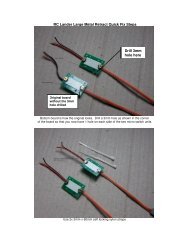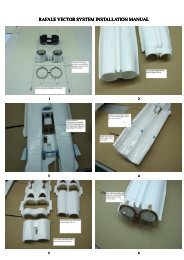Download Blade 300X RC Helicopter Manual - RCLander Retail ...
Download Blade 300X RC Helicopter Manual - RCLander Retail ...
Download Blade 300X RC Helicopter Manual - RCLander Retail ...
You also want an ePaper? Increase the reach of your titles
YUMPU automatically turns print PDFs into web optimized ePapers that Google loves.
Transmitter and Receiver Binding<br />
Binding is the process of programming the receiver to recognize the GUID (Globally Unique Identifier) code of a single specific transmitter. You need to ‘bind’ your<br />
chosen Spektrum DSM2/DSMX technology equipped aircraft transmitter to the receiver for proper operation.<br />
Binding Procedure<br />
1. Program your transmitter using the Transmitter Setup found in this manual.<br />
2. Insert the bind plug in the BND/DAT port on the receiver.<br />
3. Connect the flight battery to the ESC. The H menu LED should be flashing, indicating the AR7200BX is in bind mode.<br />
4. Move the throttle stick to the desired failsafe position (low throttle position in normal mode).<br />
5. Follow the procedures of your specific transmitter to enter Bind Mode. The system will connect within a few seconds. Once connected, the H LED will<br />
turn off and the AR7200BX will start the initialization process.<br />
6. When the initialization process is complete, the Status LED light will come ON solid BLUE.<br />
7. Disconnect the flight battery and remove the bind plug from the AR7200BX. Store the bind plug in a convenient place.<br />
NOTICE: Remove the bind plug to prevent the system from entering bind mode the next time the power is turned on.<br />
If you encounter problems, obey binding instructions and refer to transmitter troubleshooting guide for other instructions. If needed, contact the appropriate<br />
Horizon Product Support office.<br />
For a list of compatible DSM transmitters, please visit www.bindnfly.com.<br />
Throttle Hold<br />
Throttle hold only turns off the motor on an electric helicopter. You must<br />
maintain pitch and direction control.<br />
The blades will spin if throttle hold is OFF. For safety, turn throttle hold ON any<br />
time you need to touch the helicopter or check the direction controls.<br />
Throttle hold is also used to turn off the motor if the helicopter is out of control,<br />
in danger of crashing, or both.<br />
Please refer to your transmitter manual for more information on programming<br />
throttle hold.<br />
Installing the Flight Battery<br />
1. Lower the throttle.<br />
2. Power on the transmitter.<br />
3. Center the throttle trim.<br />
4. To allow the ESC to arm and to keep rotors from initiating at startup, turn<br />
on throttle hold and normal flight mode before connecting the flight<br />
battery. Please refer to your transmitter manual for more information on<br />
programming throttle hold and normal flight mode.<br />
5. Attach hook material to the helicopter frame and loop material to the<br />
battery.<br />
6. Install the flight battery on the helicopter frame. Secure the flight battery<br />
with a hook and loop strap. Connect the battery cable to the ESC.<br />
CAUTION: Always keep the power lead positioned AWAY from the elevator<br />
servo. Failure to do so could cause the lead to get caught and will<br />
result in crash causing property damage and injury.<br />
CAUTION: Make sure the flight battery does not come in contact with<br />
the motor. Failure to do so will cause the motor, ESC and battery to<br />
overheat, resulting in crash, causing property damage and injury.<br />
7. Do not move the helicopter until the AR7200BX initializes. The swashplate<br />
will move up and down indicating that the unit is ready. The AR7200BX<br />
will also emit a solid BLUE Status LED when it is ready<br />
8. The helicopter motor will emit 2 tones, indicating the ESC is armed.<br />
CAUTION: Always disconnect the Li-Po battery from the aircraft receiver when not flying to avoid over-discharging the battery. Batteries discharged to a<br />
voltage lower than the lowest approved voltage may become damaged, resulting in loss of performance and potential fire when batteries are charged.<br />
EN<br />
8








